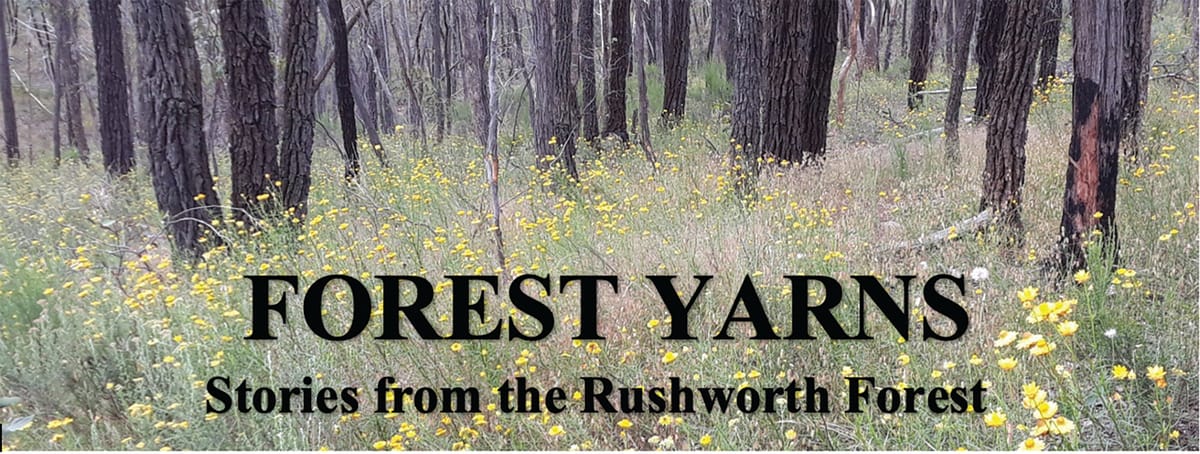Forest Yarns No 3
Stories from the Rushworth Forest

The squatting era and the gold rush
Following in the footsteps of the Major Mitchell expedition in 1836, squatters quickly moved onto much of the suitable grazing land across the Waranga area. Generally speaking, the squatters were interested in land that was ready made for sheep, and to a lesser extent, cattle grazing i.e. open woodlands and grassy plains which needed minimal clearing. Ironically, some of these areas had resulted from regular firestick burning by the local Aboriginal people.
An early visitor to the area, George Willmer noted in 1853, as he passed through the forest, “sterile mountains, covered with ironstone and quartz, without any grass worthy of the name.”1 In other words, no good for sheep and cattle.
Squatters also needed access to reliable water for their stock. Water was scarce in the forest, especially during the drier months. As a result, the box-ironbark country south of Rushworth was not of great interest to them.
The squatters had minimal impact on the forest which, up until then, was largely unchanged over millennia by the original custodians, the Ngurai-illum Wurrung people. In areas taken up for squatting runs, where it was considered that there were too many trees e.g. Waranga Park station on the current site of Waranga Basin they would be ringbarked and left to die.
At a squatting run headquarters, there may have been a few substantial buildings, but the quantity of timber used would have been minor in comparison to later eras. A typical squatter’s outstation would only be comprised of a log hut for the men and some basic timber stockyards to accommodate the sheep at night. The hutkeepers and shepherds would use minimal other timber, apart from for their firewood.
Gold rush
With the gold rush came the most dramatic change that the Rushworth forest has ever seen. The early alluvial diggers really had little use for timber and simply wanted to get rid of it as quickly as possible so that they could access the gold-bearing dirt and gravel. Vast areas were clear-felled, with a lot of the timber going to waste.
Patches of blue and green mallee were burned. Another early visitor to the forest said that “the valleys are covered with what they call whipstick scrub – a scrub of dwarf gum trees, which run about twelve feet high or so, growing densely side by side, and so locked together with cord like runners (ed. snottygobble?), that it is impossible to penetrate them.”1 Of course, he was talking about patches of blue and green mallee.
Diggers used some of the timber to cut props (both round and split) to shore up their mines and build huts, as well as for firewood. As the alluvial gold quickly petered out through the 1850s, to be largely replaced by underground quartz reef mining, demand for timber for the mines started to increase dramatically. As well as being used in the mines, firewood was required to power the steam engines which were used in turn to power the batteries used for crushing gold-bearing rock and quartz. As timber was exhausted in bigger gold mining centres like Bendigo, eyes turned to the seemingly limitless supplies in areas like the Rushworth-Heathcote forest.
Gold mining continued through the last half of the 19th century on an industrial scale, with much of the surrounding country being almost denuded of forest. Early photos of Rushworth and Whroo show places like Growler’s Hill and Balaclava Hill completely bare.
With the slow decline in mining activity as the century progressed, the industry’s demand for timber also declined. Records of product coming out of the Rushworth forest2 show that the demand for props, poles and slabs used in mining had pretty much ended by the start of the first world war. There were brief flurries into the 20th century when demand for mining timber increased again, but they were short-lived. By then, the timber from the forest was being converted into other end-products.
Regrowth
Such was the devastation wrought by the mining industry on box-ironbark forests, it is hard to know what the forest looked like prior to the gold rush. Most of the trees we see these days are from regrowth. There are few trees old enough to have hollows. The understorey would also have changed immeasurably from that existing pre-mining days.
References: 1 Lawrence, Ruth and Bellette, Marc, Gold, Timber, War and Parks: A History of the Rushworth Forest in Central Victoria (CSIRO Publishing 2010); 2 Public Records Office of Victoria, State Forests Output Books (Rushworth 1916-29)




